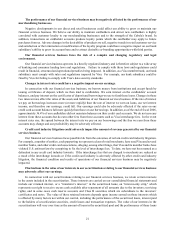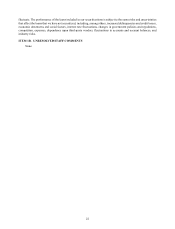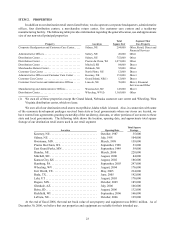Cabela's 2006 Annual Report Download - page 19
Download and view the complete annual report
Please find page 19 of the 2006 Cabela's annual report below. You can navigate through the pages in the report by either clicking on the pages listed below, or by using the keyword search tool below to find specific information within the annual report.15
goods from WTO members, which in certain instances affords us greater flexibility in importing textile and apparel
products from WTO countries from which we source our merchandise. However, as the removal of quotas resulted in
an import surge from China, the United States in May 2005 imposed safeguard quotas on seven categories of goods
and apparel imported from China. Effective January 1, 2006, the United States imposed quotas on approximately
twelve categories of goods and apparel from China, and may impose additional quotas in the future. These and other
trade restrictions could have a significant impact on our sourcing patterns in the future. Trade restrictions, including
increased tariffs or quotas, embargoes, safeguards and customs restrictions against apparel items, as well as U.S.
or foreign labor strikes, work stoppages or boycotts could increase the cost or reduce the supply of merchandise
available to us or may require us to modify our current business practices, any of which could hurt our profitability.
Due to the seasonality of our business, our annual operating results would be adversely affected if our
revenue during the third and fourth fiscal quarters were substantially below expectations.
We experience seasonal fluctuations in our revenue and operating results. Historically, we have realized a
significant portion of our revenue and substantially all of our earnings for the year during the third and fourth fiscal
quarters, with a majority of the revenue and earnings for these quarters realized in the fourth fiscal quarter. In
fiscal 2006, we generated 23.8% and 37.8% of our revenue, and 17.5% and 62.2% of our net income, in the third and
fourth fiscal quarters, respectively. We incur significant additional expenses in the third and fourth fiscal quarters
due to higher customer purchase volumes and increased staffing. If we miscalculate the demand for our products
generally or for our product mix during these two quarters, our revenue could decline, which would harm our
financial performance. In addition, abnormally warm weather conditions during the third and fourth fiscal quarters
can reduce sales of many of the products normally sold during this time period and inclement weather can reduce
store traffic or cause us to temporarily close stores causing a reduction in revenue. Because a substantial portion of
our operating income is derived from our third and fourth fiscal quarter revenue, a shortfall in expected third and
fourth fiscal quarter revenue would cause our annual operating results to suffer significantly.
A decline in discretionary consumer spending could reduce our revenue.
Our revenue depends on discretionary consumer spending, which may decrease due to a variety of factors
beyond our control, including:
• unfavorable general business conditions;
• increases in interest rates;
• increases in inflation;
• wars, fears of war and terrorist attacks and organizing activities;
• increases in consumer debt levels and decreases in the availability of consumer credit;
• adverse or unseasonable weather conditions or events;
• increases in gasoline prices reducing the willingness to travel to our destination retail stores;
• adverse changes in applicable laws and regulations;
• increases in taxation;
• adverse unemployment trends; and
• other factors that adversely influence consumer confidence and spending.
Our customers’ purchases of discretionary items, including our products, could decline during periods when
disposable income is lower or periods of actual or perceived unfavorable economic conditions. If this occurs, our
revenue would decline.
If we lose key management or are unable to attract and retain the talent required for our business, our
operating results could suffer.
Our future success depends to a significant degree on the skills, experience and efforts of Dennis Highby,
our President and Chief Executive Officer, and other key personnel including our senior executive management
and merchandising teams. With the exception of our Chairman, Richard N. Cabela, and our Vice Chairman, James
























